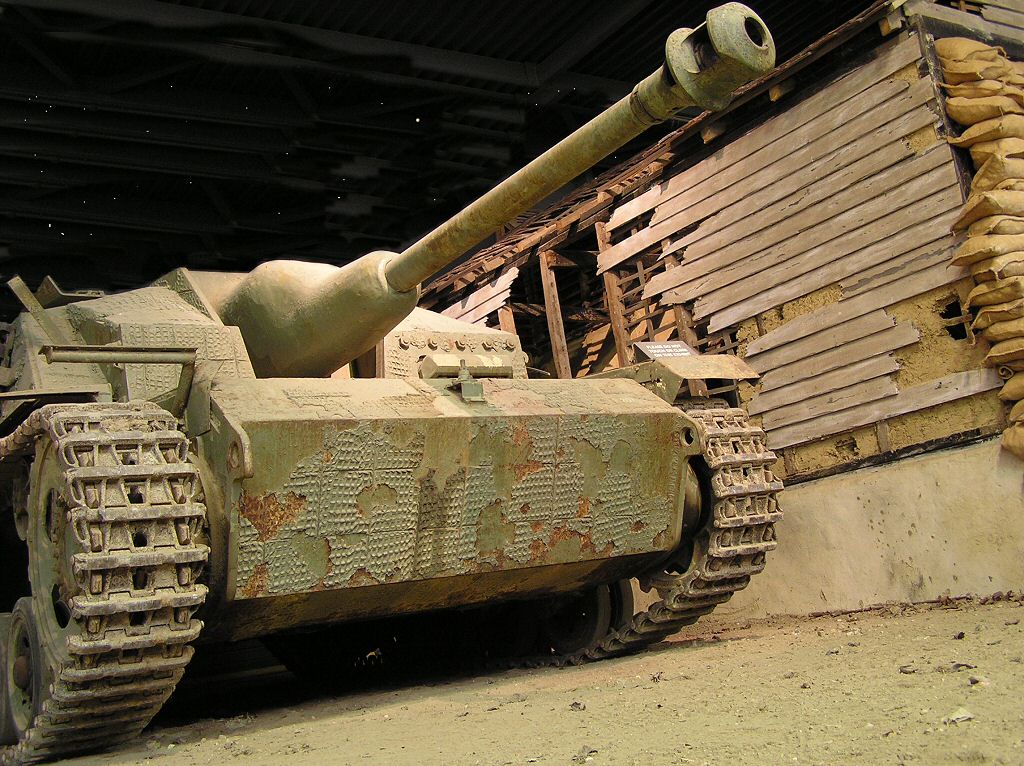|
|
|
How to
download the photographic computer wallpaper www.MooreWallpaper.com Tell your friends about us, e-mail them! |
The German Army WW2 StuG III Armoured self-propelled gunIn 1935 the German Army highlighted a need for infantry units to have the support of an artillery gun that was mobile and had the protection of armour. It was required to be under infantry control and deal with enemy machine guns emplacements. The armoured self-propelled gun was born. It was not intended to attack like a tank and does not fight in large numbers like the tank units. It should make a tactical surprise appearance, deal with the problem and then quickly vanish before it can become a target for enemy artillery. It had to be capable of knocking out enemy tanks Daimler-Benz AG were given the contract. Daimler-Benz AG being already involved in the development and production of Panzerkampfwagen III tank decided to use its chassis and components for this new vehicle. In 1937 Five prototype StuG III Ausf A vehicles were built. StuG is short for Sturmgeschütz which translated means Assault Gun. The Panzer IV’s (PzKpfw IV) short-barreled 75mm L/24 howitzer was mounted on a Panzer III’s chassis. The frontal armor, chassis nose plates, gun mantlet and frontal armor of the superstructure was increased from 30mm to 50mm thick, which was sufficiently thick to offer protection against the antitank guns of that time. Production started in 1940 and were used in the Blitzkrieg campaign of western Europe. They successfully destroyed pill-boxes, machinegun nests and antitank guns in Holland and France. The StuG III Assault Guns were not as complex or expensive to build as a Tank but they had almost the same performance as a tank. Four StuG III Ausf Gs could be purchased for the cost of single King Tiger tank. For this reason the German Army manufacture of assault guns increased until more were being made than tanks. Sturmgeschütz were found to be easier to use from concealed positions because of their lower silhouette. When infantry units were faced with large enemy numbers the StuG III Assault Guns could even up the balance. In the autumn of 1940 the StuG III Ausf. B was issued to infantry regiments. It had an improved chassis with replaced transmission and engine. The StuG III Ausf A only had 36cm wide track. The StuG III Ausf B was given 40cm wide track, making it necessary to fit new drive sprockets and rear idlers. In early 1941 the StuG III Ausf. C and D were issued. They had an altered superstructure with a single or binocular gunner's sight now mounted in the roof, eliminating the weak point in the frontal armour. There were some internal alterations. The front, side and driver's roof plates were improved to a more effective shape. The last short-barreled version was the StuG III Ausf. E which was designed as a command vehicle. The angled side plates were removed, and a second armoured pannier box was placed on the right side, while the left pannier was lengthened. These boxes contained extra radio equipment and extra ammunition rounds. The two whip antennas on the back of the superstructure are good identification points. 320 StuG III Ausf. Bs were made, 50 StuG III Ausf. Cs were made,C, 150 StuG III Ausf. Ds were made and 272 StuG III Ausf. Es were made, The later versions of the StuG III had the long-barreled 75mm L/48 guns and were mostly used in an antitank role, more armored artillery-vehicles were needed to support the infantry against soft and hidden targets. In November 1942 the StuG III Ausf. F mounted the 105mm F.H. 18 howitzer. This version of the StuG III was designated Sturmhaubitze (StuH 42). It was manly confined to a purely anti-personnel role. It did not fire armour-piercing ammunition but like most howitzers it was supplied with hollow-charge ammunition to give it some anti-armour performance. The StuG Ausf. G and had a larger barrel fitted with a double-baffle muzzle brake. StuG III units have been credited with the destruction of 20.000 Russian tanks by Spring 1944. The importance of their role as an Anti Tank weapon increased as the war progressed into a defensive war for the German Army. Stug III assault guns served on all fronts of WWII to the end of the war. 359 plus one prototype Stug III Ausf Fs were made. 334 Stug III Ausf F/8s were made. 7720 plus 173 conversions of the Stug III Ausf Gs were made. Early Stug IIIs remained in active service until mid 1943. Some were recalled to the factory to be rearmed with better guns and up-armored by the addition of armour plates. Some damaged Stug III Ausf F/8 were converted into flame-thrower tanks armed with 14mm Flammenwerfer. Model Armored Tanks, Assault Guns, Tank Destroyers & AFVThere are many companies that now make model kits of Armored Tanks, Assault Guns, Tank Destroyer, AFV & Military Vehicles in various scales. Here are a few of them. Fujimi 1/76 plastic kit, Hinchliffe Skytrex in 1/76 scale, RAFM, AIRFIX model, Revell, MILICAST, Bandai, Academy model kits, Boford models, combat group dynamix, corgi, doyusha, 1/35 scale, 1/144 micro scale, 1/72 scale, Minichamps military diecast vehicles, Marui shooting tanks, Popy, modles, Revel, Solido, Takara, Tamiay, Tamiya, F-toys, Forces of Valour, Trumpeter, Franklin mint, Wartanks, resin, diecast, Furuta, Gaincorps, Dioramas, verlinden decals, Dragon, armour, ICM models, Italeri, Haasegwa, Testor, AFV club |
www.MooreWallpaper.com Add our site to your 'Favorites' list now!
![]()
![]() (Website
design by Craig
Moore, London, England)
(Website
design by Craig
Moore, London, England)
